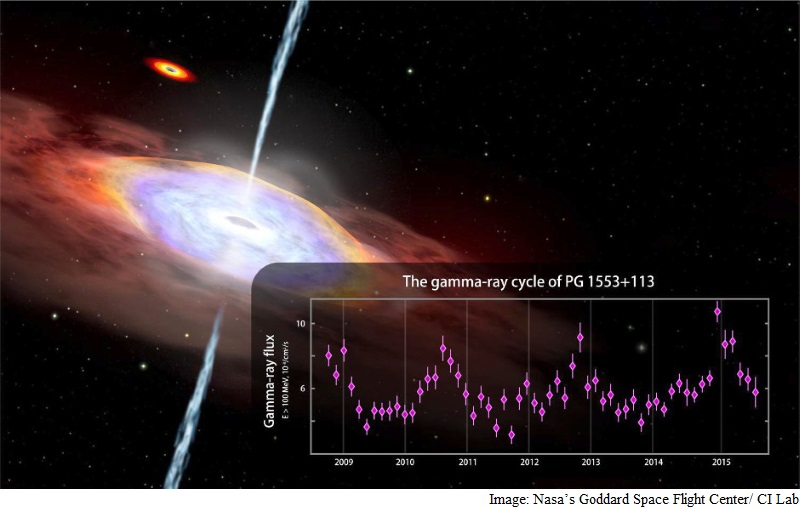- Home
- Science
- Science News
- Nasa Telescope Spots Hints of Gamma Ray Cycle in 'Active' Galaxy
Nasa Telescope Spots Hints of Gamma-Ray Cycle in 'Active' Galaxy

If confirmed, the discovery would mark the first years-long cyclic gamma-ray emission ever detected from any galaxy, providing new insights into physical processes near the black hole.
"Looking at many years of data from Fermi's Large Area Telescope (LAT), we picked up indications of a roughly two-year-long variation of gamma rays from a galaxy known as PG 1553+113," said Stefano Ciprini, who coordinates the Fermi team at the Italian Space Agency's Science Data Center (ASDC) in Rome.
"This signal is subtle and has been seen over less than four cycles, so while this is tantalising we need more observations," he added.
Supermassive black holes lie at the hearts of most large galaxies, including our own Milky Way.
In about one percent of these galaxies, the monster black hole radiates billions of times as much energy as the sun, emission that can vary unpredictably on timescales ranging from minutes to years.
Astronomers refer to these as "active" galaxies.
More than half of the gamma-ray sources seen by Fermi's LAT are active galaxies called blazars.
If the gamma-ray cycle of PG 1553+113 is in fact real, the scientists predict it will peak again in 2017 and 2019, well within Fermi's expected operational lifetime.
PG 1553+113 lies in the direction of the constellation Serpens, and its light takes about five billion years to reach Earth.
Nasa's Fermi Gamma-ray Space Telescope was launched in June 2008.
The findings were published in The Astrophysical Journal Letters.
Get your daily dose of tech news, reviews, and insights, in under 80 characters on Gadgets 360 Turbo. Connect with fellow tech lovers on our Forum. Follow us on X, Facebook, WhatsApp, Threads and Google News for instant updates. Catch all the action on our YouTube channel.
Related Stories
- Samsung Galaxy Unpacked 2025
- ChatGPT
- Redmi Note 14 Pro+
- iPhone 16
- Apple Vision Pro
- Oneplus 12
- OnePlus Nord CE 3 Lite 5G
- iPhone 13
- Xiaomi 14 Pro
- Oppo Find N3
- Tecno Spark Go (2023)
- Realme V30
- Best Phones Under 25000
- Samsung Galaxy S24 Series
- Cryptocurrency
- iQoo 12
- Samsung Galaxy S24 Ultra
- Giottus
- Samsung Galaxy Z Flip 5
- Apple 'Scary Fast'
- Housefull 5
- GoPro Hero 12 Black Review
- Invincible Season 2
- JioGlass
- HD Ready TV
- Laptop Under 50000
- Smartwatch Under 10000
- Latest Mobile Phones
- Compare Phones
- Redmi Note 15 5G
- Redmi Note 15 Pro 5G
- Redmi Note 15 Pro+ 5G
- Lava Play Max
- Poco C85 5G
- Honor Magic 8 Lite
- Jolla Phone
- Realme P4x 5G
- Asus ProArt P16
- MacBook Pro 14-inch (M5, 2025)
- OnePlus Pad Go 2
- Poco Pad M1
- Just Corseca Skywatch Pro
- Honor Watch X5
- Acerpure Nitro Z Series 100-inch QLED TV
- Samsung 43 Inch LED Ultra HD (4K) Smart TV (UA43UE81AFULXL)
- Asus ROG Ally
- Nintendo Switch Lite
- Haier 1.6 Ton 5 Star Inverter Split AC (HSU19G-MZAID5BN-INV)
- Haier 1.6 Ton 5 Star Inverter Split AC (HSU19G-MZAIM5BN-INV)

















